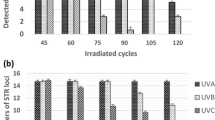Abstract
The ability to detect DNA polymorphisms using molecular genetic techniques has revolutionized the forensic analysis of biological evidence. DNA typing now plays a critical role within the criminal justice system, but one of the limiting factors with the technology is that DNA isolated from biological stains recovered from the crime scene is sometimes so damaged as to be intractable to analysis. Potential remedies for damaged DNA are likely to be dependent upon the precise nature of the DNA damage present in any particular sample but, unfortunately, current knowledge of the biochemical nature, and the extent, of such DNA damage in dried biological stains is rudimentary. As a model for DNA damage assessment in biological stains recovered from crime scenes, we have subjected human bloodstains and naked DNA in the hydrated and dehydrated states to varying doses of UVC radiation. It was possible to damage the DNA sufficiently in a bloodstain to cause a standard autosomal short tandem repeat (STR) profile to be lost. However, a detailed analysis of the process, based upon assays developed to detect bipyrimidine photoproducts (BPPPs), single- and double-strand breaks, and DNA–DNA crosslinks, produced some unexpected findings. Contrary to the situation with living tissues or cells in culture, the predominant UVC-induced damage to DNA in bloodstains appears not to be pyrimidine dimers. Although some evidence for the presence of BPPPs and DNA crosslinks was obtained, the major form of UVC damage causing genetic profile loss appeared to be single-strand breaks. It was not possible, however, to preclude the possibility that a combination of damage types was responsible for the profile loss observed. We demonstrate here that a significant measure of protection against UVC-mediated genetic profile loss in dried biological stain material is afforded by the dehydrated state of the DNA and, to a lesser extent, the DNA cellular milieu.







Similar content being viewed by others
References
Lindahl T (1993) Nature 362:709–715
McNally L, Shaler RC, Baird M, Balazs I, De Forest P, Kobilinsky L (1989) J Forensic Sci 34:1059–1069
McNally L, Shaler RC, Baird M, Balazs I, Kobilinsky L, De Forest P (1989) J Forensic Sci 34:1070–1077
Hoss M, Jaruga P, Zastawny TH, Dizdaroglu M, Paabo S (1996) Nucleic Acids Res 24:1304–1307
TWGDAM (1995) Crime Lab Dig 22:21–43
Budowle B, Moretti TR, Keys KM, Koons BW, Smerick JB (1997) J Forensic Sci 42:701–707
Cosso S, Reynolds R (1995) J Forensic Sci 40:424–434
Adams DE, Presley LA, Baumstark AL, Hensley KW, Hill AL, Anoe KS, Campbell PA, McLaughlin CM, Budowle B, Giusti AM et al (1991) J Forensic Sci 36:1284–1298
Lins AM, Micka KA, Sprecher CJ, Taylor JA, Bacher JW, Rabbach DR, Bever RA, Creacy SD, Schumm JW (1998) J Forensic Sci 43:1168–1180
Wallin JM, Buoncristiani MR, Lazaruk KD, Fildes N, Holt CL, Walsh PS (1998) J Forensic Sci 43:854–870
Friedberg ECWG, Siede W (1995) DNA repair and mutagenesis. ASM Press, Washington
Chandrasekhar D, Van Houten B (2000) Mutat Res 450:19–40
Todo T (1999) Mutat Res 434:89–97
Comey CTKB, Presley KW, Smerick JB, Sobieralski CA, Stanley DM, Baechtel FS (1994) J Forensic Sci 39:1254–1269
Rosenstein BS, Rosenstein RB (1992) J Photochem Photobiol B 16:247–255
Kuluncsics Z, Perdiz D, Brulay E, Muel B, Sage E (1999) J Photochem Photobiol B 49:71–80
Yoon JH, Lee CS, O’Connor TR, Yasui A, Pfeifer GP (2000) J Mol Biol 299:681–693
Garvish JF, Lloyd RS (1999) J Biol Chem 274:9786–9794
Nakabeppu Y, Yamashita K, Sekiguchi M (1982) J Biol Chem 257:2556–2562
Avery AM, Kaur B, Taylor JS, Mello JA, Essigmann JM, Doetsch PW (1999) Nucleic Acids Res 27:2256–2264
Wehner J, Horneck G (1995) J Photochem Photobiol B 30:171–177
Author information
Authors and Affiliations
Corresponding author
Rights and permissions
About this article
Cite this article
Hall, A., Ballantyne, J. Characterization of UVC-induced DNA damage in bloodstains: forensic implications. Anal Bioanal Chem 380, 72–83 (2004). https://doi.org/10.1007/s00216-004-2681-3
Received:
Revised:
Accepted:
Published:
Issue Date:
DOI: https://doi.org/10.1007/s00216-004-2681-3




